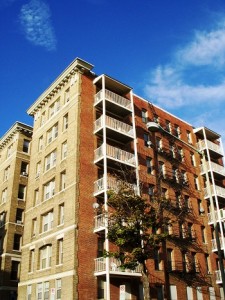I think we all can bring up an image of flames shooting out of an apartment or hotel room in a high-rise, with smoke billowing. It’s so that when I travel, I request a room on a lower floor, and near the stairs – all because of those images!

Where are the exits?
The recent fire in West LA got me to look into the realities of emergency preparedness for people living in high-rises, however, and the results weren’t exactly what I was expecting.
Here’s some of what I learned.
The danger of fire in a high-rise is LESS than in other structures!
The National Fire Protection Agency, excellent resource for all things fire-related, reports that only 3% of structural fires are in high-rise buildings. (They define high-rise as 7 stories or taller. There are other definitions; I’m defining high-rise as anything above the height of the local fire department’s highest ladder.)
A fire in a high-rise results in statistically less damage.
Modern hotels and apartment buildings, where about half the high-rise fires occur, are far more likely than other structures to have:
* Construction that resists fire. Steel with spray-on coatings or encased with concrete resists fire far longer than wood construction. If you’re familiar with fire insurance, you know that buildings are rated for how resistive their construction methods are.
* Systems to protect against fire. Depending on size the building, it may have fire alarms and automatic sprinklers. Larger buildings may have camera surveillance, controlled access and even 24-hour monitoring.
OK, that’s great for statistics. But what about me?
If you actually plan to live in a high-rise apartment, what should you find out about the building?
Take a tour of the building with management, and get answers to these five questions:
- What fire safety systems does the building have, and who maintains them? Don’t assume anything! The LA fire happened in a building with no sprinklers.
- Are exits clearly marked? In an emergency, elevators won’t be available.
- Are the fire exits unlocked? Are fire doors kept closed, not propped open?
- Does the building have a fire evacuation plan? What about fire drills?
- Does the fire alarm system have a public announcement capability?
And if a fire breaks out, what should you do?
The U.S. Fire Administration, part of FEMA, offers guidelines for how to protect yourself and how to save yourself. Here are highlights:
- Call the fire department yourself to report a fire. Nobody else may have called!
- When you hear a fire alarm, feel the exit door of the apartment with the back of your hand.
a. If it’s cool, open the door carefully. Do you see smoke or flames? If all clear, head for the nearest exit. If you encounter smoke, turn back! According to FEMA, smoke and toxic gases kill more people than flames do.
b. If the door is warm, or you see smoke, do not go out! Stay in your apartment. Stuff the cracks around the door with towels or bedding. Turn off the air conditioning. Keep smoke from coming into the apartment. To quote again from FEMA, “Asphyxiation is the leading cause of fire deaths, exceeding burns by a three-to-one ratio.”
- Call the fire department to let them know where you are. Signal from a window. Don’t leave it open if smoke is coming in.
- Listen for instructions from the fire department.
- Be patient. It may take hours for a high-rise to be fully evacuated.
Do you live now in a high-rise apartment? If not, who do you know that does?
Since nearly 40% of Americans are renters, and the majority of them live in apartments, you are bound to have friends or family in this category.
Action Item: Please share this information. You can simply forward the blog post, or copy and paste it into an email or onto an attachment or link to it on your own Facebook page.
Thank you. Your action may save lives.
Virginia Nicols
Your Emergency Plan Guide Team
Don't miss a single Advisory.
Thank you for subscribing.
Something went wrong.
